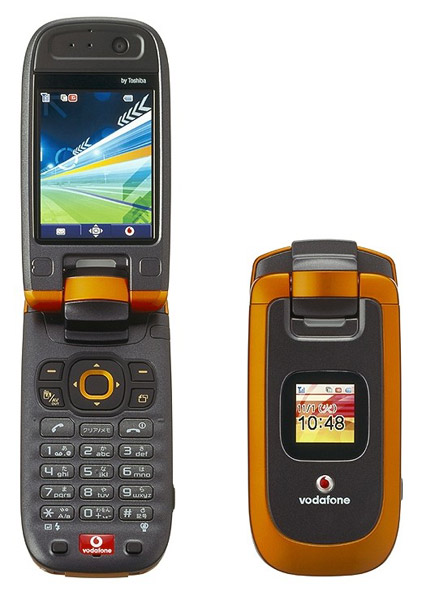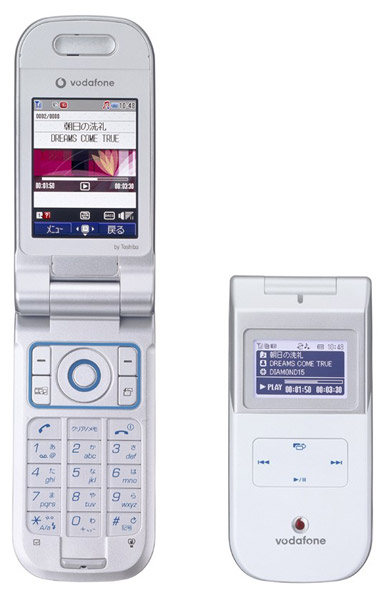New 3G Phones from Vodafone Japan
Japan’s lost souls and the musically minded are targets for two new W-CDMA 3G handsets from Vodafone Japan, the 903T and 803T, both by Toshiba. Scheduled for an October release, the 903T finally puts Vodafone on the real-time mobile GPS navigation map (rivals DoCoMo and KDDI have had network GPS phones for some time). Vodafone’s “Live Navi” navigation portal goes the competition one better with the addition of GPS global roaming options in the UK, Hong Kong, Holland, Spain and Germany — with more countries to follow. Of course, international roaming and Vodafone live! communication charges will apply, which might make it cheaper just to buy a guidebook.
Here in Japan, the navi service will map out routes according to specialized needs — like fewer stairs or covered access for when those typhoons hit. Vodafone’s main partner in mapping is well-known navigation data supplier Zenrin, which handles most of the live walk-through navigation and panorama shots via a split screen to show users just what they should be seeing on their route. Other partners specialize in train and subway routing, area-based restaurant maps or shopping information, as well as an international travel info site.
The 903T has a 2.4-inch QVGA screen, 1.92-megapixel camera, SD memory card, USB connectivity, bilingual menus, QR code reader and also supports Chaku Uta Full (full music download service).

Next, Vodafone have taken the popular Japanese trend of combining MP3 players and mobile handsets into one unit and created its second autumn handset, the 803T.

Aimed primarily at young female users, this model incorporates an iPod-like front screen sub-display to scroll through music titles and song info. The unit comes with stereo headphones and microphone with music control functions. Built-in batteries provide around seven hours of continuous music play; music can be downloaded or ripped from CDs using Toshiba’s proprietary Beat Music software onto mini SD memory disks. Security is automatically keyed in to the individual handset’s phone number — that means no file sharing on downloads or disk swapping with pals even with the same model handset. This, for consumers, is probably the biggest drawback to the 803T. Even Apple lets you share your iPod music to some degree!
The handset is also equipped with a 2.26-megapixel camera, twin stereo speakers, an electronic dictionary and supports the Live!BB music and video content downloading service.
Vodafone’s press launch for these handsets took place 7 September at Tokyo’s Imperial Hotel. Though not overflowing, the smallish 4th-floor event room was well attended by the press, drawn perhaps by the scent of blood on the water. After all, Vodafone has been pretty good at chumming the Japan KK operations for the media sharks.
Last April’s dismal global release of 3G handsets elicited more yawns than gasps from the sophisticated Japanese market. Power outages last fall, billing problems during the summer, plus slow transmission speeds have not endeared the company to Japanese consumers or technology analysts. Financials have been poor, to say the least. Average revenue per customer has reportedly been on the decline and Vodafone KK — the Japan division unit of parent Vodafone — was hit with a net decrease of 72,000 subscribers during the April-June quarter.
Mobile phones are fast reaching saturation point in the world’s second largest mobile market and it is imperative for providers to hold onto subscribers with a compelling own mix of content and technology. Vodafone needs to set itself apart not only from KDDI and DoCoMo but new companies saddling up to ride the 3G wireless range. Softbank turned in its application for a wireless license on 6 September and hopes to start nibbling at the profits of the big boys by 2007. eAccess and partner Tokyo Broadcasting System have said they plan to apply for a license as well.
Despite back-end problems, Vodafone Japan’s marketing division has been working hard to restore a little luster to what started out as a very innovative brand. Some of these moves have (literally) been merely cosmetic — like last spring’s playful slip-on handset skins. With the 903T and 803T, at least Vodafone (and Toshiba) have created some competitive models.
The navigation features, in particular, could keep some users from deserting the Vodafone brand for KDDI and their EZ Navi Walk service. Even for natives, Japan is a hard country to navigate, in every sense of the word (something Vodafone’s corporate HQ has taken time to understand). In a 25 July telephone press conference reported in local Japanese media, Vodafone President and CEO Arun Sarin in Europe reportedly hinted they might just sell the Japan unit if it did not shape up and ship out more handsets.
Hopefully, head office will step back and give the Japan division more autonomy in downloading its own road map to recovery.
— Gail Nakada

